
LOADING ...
In response to evolving domestic opinion, eMedals Inc has made the conscious decision to remove the presentation of German Third Reich historical artifacts from our online catalogue. For three decades, eMedals Inc has made an effort to preserve history in all its forms. As historians and researchers, we have managed sensitive articles and materials with the greatest of care and respect for their past and present social context. We acknowledge the growing sentiments put forth by the Canadian public and have taken proactive actions to address this opinion.
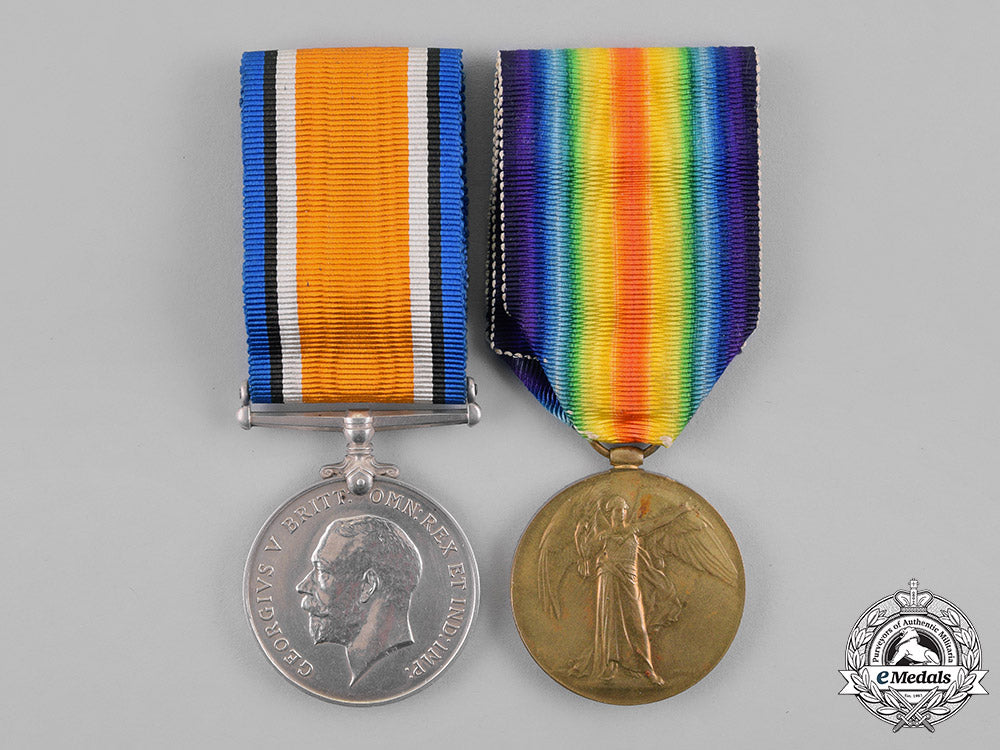
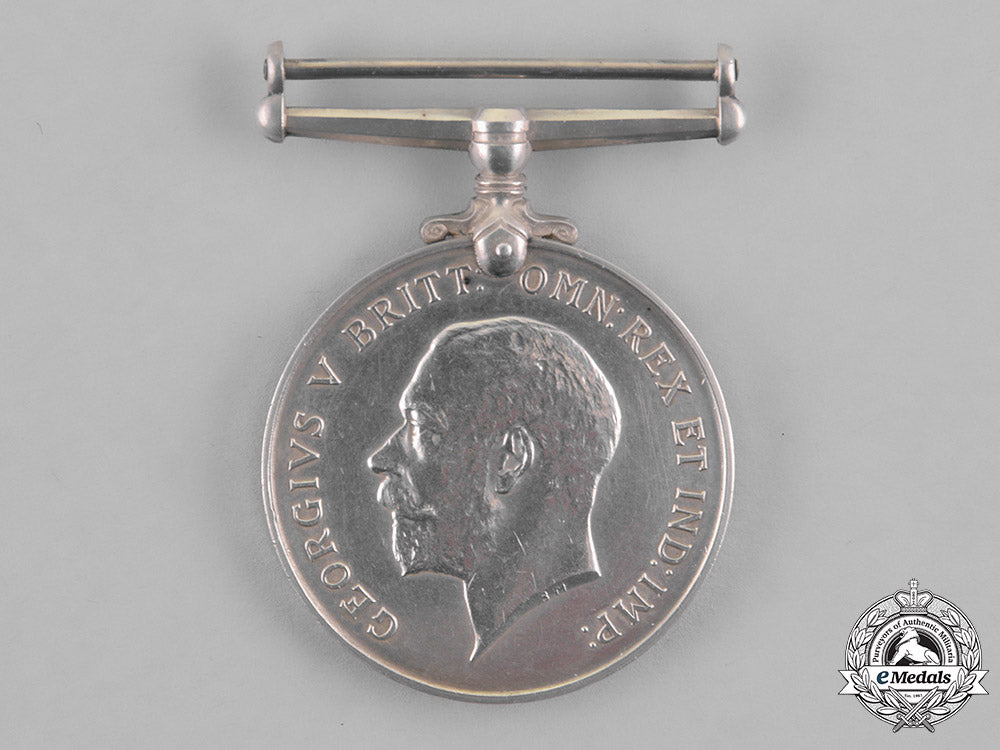
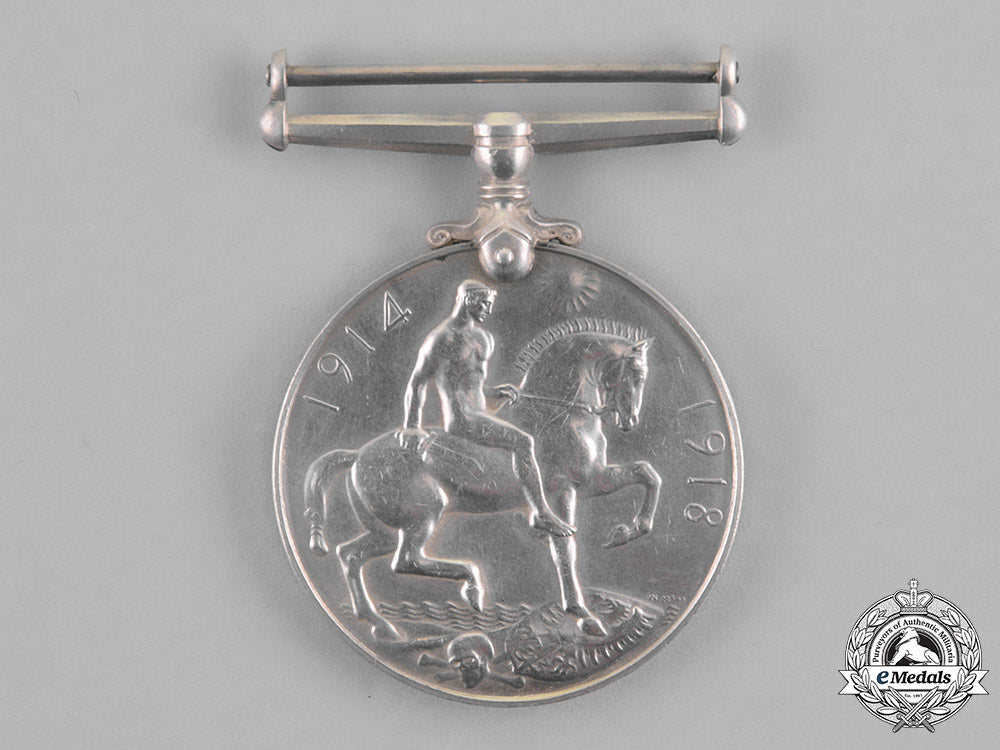
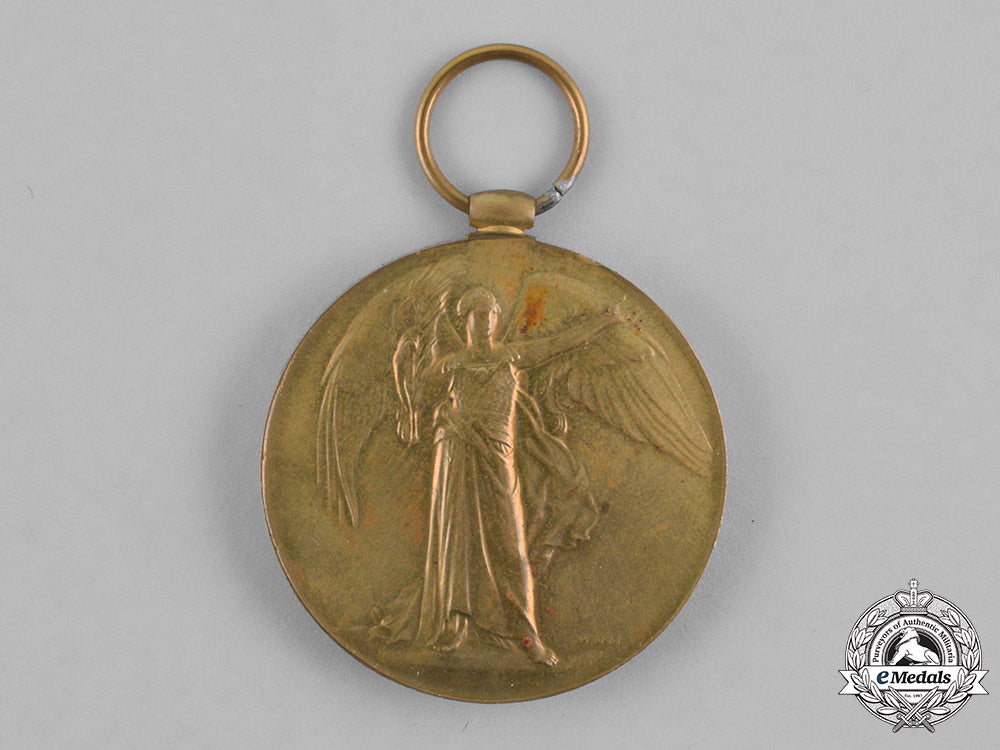
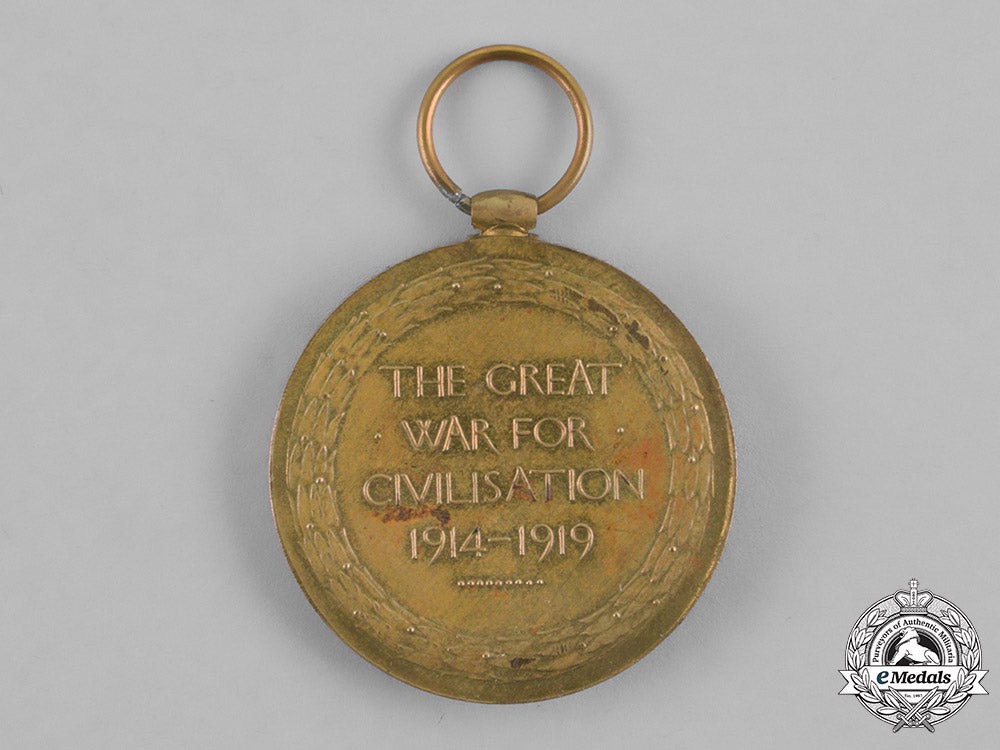
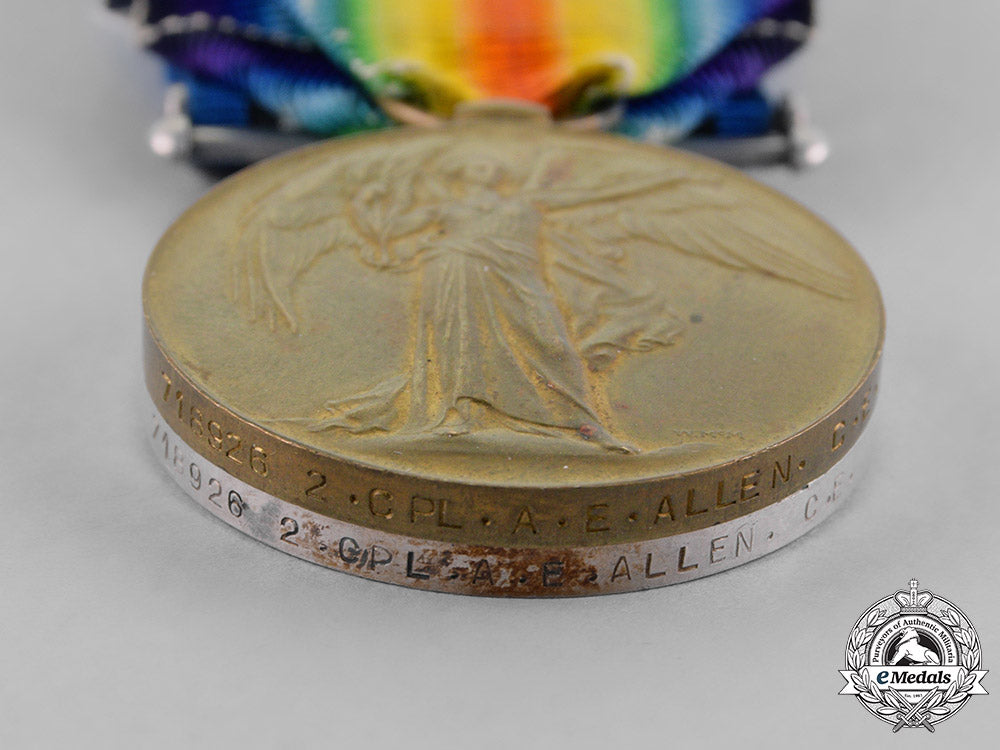
Canada. A First War Pair, 107Th Pioneer Battalion Canadian Engineers, Wounded
Canada. A First War Pair, 107Th Pioneer Battalion Canadian Engineers, Wounded
SKU: ITEM: C5698
Current Bid:
Your Max Bid:
Bid History:
Time Remaining:
Couldn't load pickup availability
Shipping Details
Shipping Details
eMedals offers rapid domestic and international shipping. Orders received prior to 12:00pm (EST) will be shipped on the same business day.* Orders placed on Canadian Federal holidays will be dispatched the subsequent business day. Courier tracking numbers are provided for all shipments. All items purchased from eMedals can be returned for a full monetary refund or merchandise credit, providing the criteria presented in our Terms & Conditions are met. *Please note that the addition of a COA may impact dispatch time.
Shipping Details
eMedals offers rapid domestic and international shipping. Orders received prior to 12:00pm (EST) will be shipped on the same business day.* Orders placed on Canadian Federal holidays will be dispatched the subsequent business day. Courier tracking numbers are provided for all shipments. All items purchased from eMedals can be returned for a full monetary refund or merchandise credit, providing the criteria presented in our Terms & Conditions are met. *Please note that the addition of a COA may impact dispatch time.
Description
Description
British War Medal (718926 2. CPL. A.E. C.E.); and Victory Medal (718926 2. CPL. A.E. ALLEN. C.E.). Naming is officially impressed. Un-mounted, surface wear, edge nicks on both, original ribbons, better than very fine.
Footnote: Alfred Edward Allen was born on August 26, 1898 in Ottawa, Ontario, the son of Alfred E. Allen (later of Chicago, Illinois) and Mary Allen (later of Winnipeg, Manitoba). He was a resident of Winnpeg when he signed his Attestation Paper as a Private (718926) with the 107th Infantry Battalion "Winnipeg Battalion", on March 22, 1916 in Winnipeg, at the age of 17, naming his next-of-kin as his mother, Mary Allen of Winnipeg, stating that he had no previous military service, that he was not married, that his religion was Church of England and that his trade was that of Bank Clerk. While training in Winnipeg, he was admitted to hospital with a case of the "Mumps" on May 25, 1916. After two weeks, he was released from hospital, having made a "good recovery" and discharged to duty on June 8th.
The Battalion was raised and mobilized in Winnipeg, Manitoba under the authority of G.O. 151, December 22, 1915. The Battalion sailed from Halifax, Nova Scotia aboard the S.S. Olympic, on September 19, 1916 under the command of Lieutenant-Colonel G. Campbell with a strength of 32 officers and 965 other ranks, arriving in Liverpool, England on the 25th. Upon arrival in England, the 107th Infantry Battalion was posted to Witley Camp. Five weeks later, the Battalion proceeded overseas for service in the French theatre on February 24, 1917, disembarking in Boulogne, France on the 25th. That Fall, Private Allen was sentenced to forfeit five days' pay on September 18, 1917, "For when on active service he was absent from a work party without permission". The Army felt that he was too young to be serving in the field and decided on September 26th, that Private Allen was to be posted to the 1st Army School of Instruction at Hardelot on October 12, 1917, "until he attains the age of 19". Four months later, he was appointed Lance Corporal without pay on February 10, 1918. The following month, his unit, the 107th Infantry Battalion was re-designated the 107th Pioneer Battalion on March 10, 1918 and would serve in France in that capacity. Allen reverted to the rank of Private at his own request on April 6, 1918 and was transferred to the Canadian Engineers Reinforcement Pool on April 30, 1918.
Private Allen was at the 1st Army School of Instruction when he was accidentally wounded, suffering a gun shot would to his neck and mouth, on September 16, 1918. One of the doctors later described the incident in a report: "While sitting in his bunk in France, a German heavy machine gun was being examined at the end of the hut. The gun exploded, wounding him in the jaw". Another doctor stated that Allen had a "chum accidentally shoot him through the mouth and going out breaking the right ramus of (the) jaw at (the) point of exit". During a subsequent investigation of the incident, Statement of Evidence was given by 416696 Lance Corporal Edgar S. Gee, 22nd Infantry Battalion, detailing the events of that day: "I am in charge of a small working party, consisting of myself and two Privates, the duties of which consist of taking from the Gun Room at the Chateau, such guns as may be required for instructional purposes and handing them over to the instructional staff at such time and place as may be detailed. After the instructional work is over, it is our duty to remove the guns to the Gun Room, clean them, and get them in readiness for the next days' work. On the the 16th inst., I was instructed to have a German Machine on the range. I took it there, and handed it to Sergt. Majors Ford and Platt. At the instructional period, S.M. Ford was firing the gun whilst was picking up the empty cartridge cases. I thought that the gun had been cleared by S.M. Ford before it was handed over to me to take away. I went to fetch another small German Machine gun and when I returned, one of my party already had the first mentioned gun on his back. S.M. Platt gave me an order to bring both guns to the hut in Camp (No. 1 in No. 1 Square) in which musketry stores are kept. We usually take these guns to the Theatre for cleaning purposes as the Musketry Stores Hut is full of material and men. On this occasion, the lecture Theatre was occupied, so I decided to bring the guns to my own hut and clean them on my bed. The heavier gun, (the one concerned in the accident) was put down near my bed. I loosened the clamp preparatory to taking the gun of its mountings and whilst doing so, accidentally touched the trigger, when a live cartridge was exploded. I have been employed for four years on work connected with automatic guns and although I have never been actually instructed that the clearance of guns before removal from the range is my responsbility at this School, I have frequently done it. I would have done so as a precautionary measure in this case, even though I was under the impression that S.M. Ford had done so, but the gun had already loaded on the man's shoulders when I got back from fetching the second one moreover, I felt sure it had been done. The gun was taken away after the accident by Ptes. Brady and Osborne, the two men of my working party, and cleaned by them. I am sure that on one else handled it before they took it away. Pte. Brady afterwards reported to me that he had cleaned it and I understand that to mean that the gun could not possibly have been loaded on the way down from the Range. It was on a man's back the whole time and moreover to load it would have entailed the usual process of inserting a belt in the feed block etc., or opening up the Cover, raising the lock and inserting a cartridge in the chamber, neither of which could have been done without my seeing it."
The day of the accident, September 16th, Allen was admitted to No. 25 General Hospital, where it was noted that he had a "comminuted fracture angle of jaw", producing multiple bone splinters of the mandible. His wound was then cleaned and dressed. The following day, September 17th, he was admitted to No. 83 General Hospital at Boulogne, where an operation was performed and the wounded cleaned. He had to wear a splint for the right jaw, with discharge in the sinus at the point of exit of the bullet. Lance Corporal Allen was invalided injured aboard the Hospital Ship Cambria to England, where he was posted to the Canadian Engineers Regimental Depot, then admitted to Queens Hospital at Sidcup, a district in south-east London, on September 20, 1918. It was here that his wound was opened and drained, followed by the application of a splint. The doctor, Major C.W. Waldon, CAMC, noted during his examination, that Allen had "Considerable mobility of the fracture. Was under splint treatment for three months. There is now strong bony union of the fracture, between the anterior portion as ascendary ramus and body. Posteriorly there is a defect due to loss of bone. Recommend invaliding to Canada."
As of October 26, 1918, it was stated for the record that "This casualty should be reported as "Injured (Accidentally)" ". He was discharged from Queens on November 11, 1918, the final day of the war. He would be admitted to No. 85 Dublin General Hospital for another operation on his jaw, interrupted by a brief stop at Royal Herbert Hospital at Woolwich on November 26th, to be treated for "Syphilis", until December 4th. Allen was admitted to No. 12 Canadian General Hospital on December 17, 1918, to have a small sequestra (pieces of dead bone that has become separated during the process of necrosis from normal or sound bone) removed. The splints were also removed and after three and a half weeks at No. 12 CGH, he was transferred to the Canadian Special Hospital at Witley, Sussex "V.D.S." (Venereal Disease, Syphilis) on January 11th. While he was being treated for Syphilis, the wound to his jaw also healed during this time. After almost four weeks at Witley, he was transferred and admitted to Queens Hospital at Sidcup on February 6, 1919 for a five day stay, before his admission to No. 16 Ontario Military Hospital at Orpington, Kent on February 11th. Three days after his arrival at Orpington, on February 14th, a full assessment of his medical condition was done, the Medical Board there recommending that Allen be invalided to Canada. During his stay at Orpington, he had developed "Jaundice" as of April 18th. One of the doctors noted that the gun shot wound to his lower jaw was "caused by a bullet wound just in front of the angle. Bone has united firmly in good position. Scar along the right side of the neck, firmly healed with marked ridge, not adherent. Some interference with Vol. power of lower right cheek and lip. Wishes to have scar excised."
His stay at Orpington would entail eleven weeks, before his transfer and admission to the Military Convalescent Home at Epsom on April 29, 1919. Allen was invalided to Canada aboard the S.S. Megantic on May 23, 1919, arriving in Canada on June 2nd. He was taken on strength at No. 10 District Depot in Winnipeg and subsequently admitted to the Manitoba Military Hospital at Tuxedo Park on June 6, 1919. It was here that he had an operation on August 5th, to have the scar excised. In his Medical History of an Invalid Report, dated August 27, 1919 at No. 10 District Depot in Winnipeg, the doctor noted that Allen had "difficulty in masticating food on (the) right side due to old fracture of right mandible" and that he "has pain at (the) site of (the) fracture about once a week. The pain is aching in character, and aggravated by cold winds. Masticates all food on (the) left side. If he uses the right, lower lip becomes pinched between teeth and sensation is dulled on this side. Is being supplied with a suitable dental plate." After three months at MMH, he was discharged from his final hospitalization on September 3rd. The accident saw him hospitalized for eleven months: four days in France, eight months in England and another three months in Canada. Lance Corporal Alfred Edward Allen was discharged as being "Medically Unfit" at No. 10 District Depot in Winnipeg, on September 9, 1919, designated Category "E" (Unfit for Service in Categories "A" (General Service), "B" (Service Abroad) and "C" (Home Service)), credited with having served in Canada, England, France and Belgium for nineteen months, entitled to wear the War Service Badge, Class "AB", number 866558 and the War Service Badge, Class "A", number 319221. He was also paid a War Service Gratuity in the amount of $600. For his First World War service, he was awarded the British War Medal and the Victory Medal.
Description
British War Medal (718926 2. CPL. A.E. C.E.); and Victory Medal (718926 2. CPL. A.E. ALLEN. C.E.). Naming is officially impressed. Un-mounted, surface wear, edge nicks on both, original ribbons, better than very fine.
Footnote: Alfred Edward Allen was born on August 26, 1898 in Ottawa, Ontario, the son of Alfred E. Allen (later of Chicago, Illinois) and Mary Allen (later of Winnipeg, Manitoba). He was a resident of Winnpeg when he signed his Attestation Paper as a Private (718926) with the 107th Infantry Battalion "Winnipeg Battalion", on March 22, 1916 in Winnipeg, at the age of 17, naming his next-of-kin as his mother, Mary Allen of Winnipeg, stating that he had no previous military service, that he was not married, that his religion was Church of England and that his trade was that of Bank Clerk. While training in Winnipeg, he was admitted to hospital with a case of the "Mumps" on May 25, 1916. After two weeks, he was released from hospital, having made a "good recovery" and discharged to duty on June 8th.
The Battalion was raised and mobilized in Winnipeg, Manitoba under the authority of G.O. 151, December 22, 1915. The Battalion sailed from Halifax, Nova Scotia aboard the S.S. Olympic, on September 19, 1916 under the command of Lieutenant-Colonel G. Campbell with a strength of 32 officers and 965 other ranks, arriving in Liverpool, England on the 25th. Upon arrival in England, the 107th Infantry Battalion was posted to Witley Camp. Five weeks later, the Battalion proceeded overseas for service in the French theatre on February 24, 1917, disembarking in Boulogne, France on the 25th. That Fall, Private Allen was sentenced to forfeit five days' pay on September 18, 1917, "For when on active service he was absent from a work party without permission". The Army felt that he was too young to be serving in the field and decided on September 26th, that Private Allen was to be posted to the 1st Army School of Instruction at Hardelot on October 12, 1917, "until he attains the age of 19". Four months later, he was appointed Lance Corporal without pay on February 10, 1918. The following month, his unit, the 107th Infantry Battalion was re-designated the 107th Pioneer Battalion on March 10, 1918 and would serve in France in that capacity. Allen reverted to the rank of Private at his own request on April 6, 1918 and was transferred to the Canadian Engineers Reinforcement Pool on April 30, 1918.
Private Allen was at the 1st Army School of Instruction when he was accidentally wounded, suffering a gun shot would to his neck and mouth, on September 16, 1918. One of the doctors later described the incident in a report: "While sitting in his bunk in France, a German heavy machine gun was being examined at the end of the hut. The gun exploded, wounding him in the jaw". Another doctor stated that Allen had a "chum accidentally shoot him through the mouth and going out breaking the right ramus of (the) jaw at (the) point of exit". During a subsequent investigation of the incident, Statement of Evidence was given by 416696 Lance Corporal Edgar S. Gee, 22nd Infantry Battalion, detailing the events of that day: "I am in charge of a small working party, consisting of myself and two Privates, the duties of which consist of taking from the Gun Room at the Chateau, such guns as may be required for instructional purposes and handing them over to the instructional staff at such time and place as may be detailed. After the instructional work is over, it is our duty to remove the guns to the Gun Room, clean them, and get them in readiness for the next days' work. On the the 16th inst., I was instructed to have a German Machine on the range. I took it there, and handed it to Sergt. Majors Ford and Platt. At the instructional period, S.M. Ford was firing the gun whilst was picking up the empty cartridge cases. I thought that the gun had been cleared by S.M. Ford before it was handed over to me to take away. I went to fetch another small German Machine gun and when I returned, one of my party already had the first mentioned gun on his back. S.M. Platt gave me an order to bring both guns to the hut in Camp (No. 1 in No. 1 Square) in which musketry stores are kept. We usually take these guns to the Theatre for cleaning purposes as the Musketry Stores Hut is full of material and men. On this occasion, the lecture Theatre was occupied, so I decided to bring the guns to my own hut and clean them on my bed. The heavier gun, (the one concerned in the accident) was put down near my bed. I loosened the clamp preparatory to taking the gun of its mountings and whilst doing so, accidentally touched the trigger, when a live cartridge was exploded. I have been employed for four years on work connected with automatic guns and although I have never been actually instructed that the clearance of guns before removal from the range is my responsbility at this School, I have frequently done it. I would have done so as a precautionary measure in this case, even though I was under the impression that S.M. Ford had done so, but the gun had already loaded on the man's shoulders when I got back from fetching the second one moreover, I felt sure it had been done. The gun was taken away after the accident by Ptes. Brady and Osborne, the two men of my working party, and cleaned by them. I am sure that on one else handled it before they took it away. Pte. Brady afterwards reported to me that he had cleaned it and I understand that to mean that the gun could not possibly have been loaded on the way down from the Range. It was on a man's back the whole time and moreover to load it would have entailed the usual process of inserting a belt in the feed block etc., or opening up the Cover, raising the lock and inserting a cartridge in the chamber, neither of which could have been done without my seeing it."
The day of the accident, September 16th, Allen was admitted to No. 25 General Hospital, where it was noted that he had a "comminuted fracture angle of jaw", producing multiple bone splinters of the mandible. His wound was then cleaned and dressed. The following day, September 17th, he was admitted to No. 83 General Hospital at Boulogne, where an operation was performed and the wounded cleaned. He had to wear a splint for the right jaw, with discharge in the sinus at the point of exit of the bullet. Lance Corporal Allen was invalided injured aboard the Hospital Ship Cambria to England, where he was posted to the Canadian Engineers Regimental Depot, then admitted to Queens Hospital at Sidcup, a district in south-east London, on September 20, 1918. It was here that his wound was opened and drained, followed by the application of a splint. The doctor, Major C.W. Waldon, CAMC, noted during his examination, that Allen had "Considerable mobility of the fracture. Was under splint treatment for three months. There is now strong bony union of the fracture, between the anterior portion as ascendary ramus and body. Posteriorly there is a defect due to loss of bone. Recommend invaliding to Canada."
As of October 26, 1918, it was stated for the record that "This casualty should be reported as "Injured (Accidentally)" ". He was discharged from Queens on November 11, 1918, the final day of the war. He would be admitted to No. 85 Dublin General Hospital for another operation on his jaw, interrupted by a brief stop at Royal Herbert Hospital at Woolwich on November 26th, to be treated for "Syphilis", until December 4th. Allen was admitted to No. 12 Canadian General Hospital on December 17, 1918, to have a small sequestra (pieces of dead bone that has become separated during the process of necrosis from normal or sound bone) removed. The splints were also removed and after three and a half weeks at No. 12 CGH, he was transferred to the Canadian Special Hospital at Witley, Sussex "V.D.S." (Venereal Disease, Syphilis) on January 11th. While he was being treated for Syphilis, the wound to his jaw also healed during this time. After almost four weeks at Witley, he was transferred and admitted to Queens Hospital at Sidcup on February 6, 1919 for a five day stay, before his admission to No. 16 Ontario Military Hospital at Orpington, Kent on February 11th. Three days after his arrival at Orpington, on February 14th, a full assessment of his medical condition was done, the Medical Board there recommending that Allen be invalided to Canada. During his stay at Orpington, he had developed "Jaundice" as of April 18th. One of the doctors noted that the gun shot wound to his lower jaw was "caused by a bullet wound just in front of the angle. Bone has united firmly in good position. Scar along the right side of the neck, firmly healed with marked ridge, not adherent. Some interference with Vol. power of lower right cheek and lip. Wishes to have scar excised."
His stay at Orpington would entail eleven weeks, before his transfer and admission to the Military Convalescent Home at Epsom on April 29, 1919. Allen was invalided to Canada aboard the S.S. Megantic on May 23, 1919, arriving in Canada on June 2nd. He was taken on strength at No. 10 District Depot in Winnipeg and subsequently admitted to the Manitoba Military Hospital at Tuxedo Park on June 6, 1919. It was here that he had an operation on August 5th, to have the scar excised. In his Medical History of an Invalid Report, dated August 27, 1919 at No. 10 District Depot in Winnipeg, the doctor noted that Allen had "difficulty in masticating food on (the) right side due to old fracture of right mandible" and that he "has pain at (the) site of (the) fracture about once a week. The pain is aching in character, and aggravated by cold winds. Masticates all food on (the) left side. If he uses the right, lower lip becomes pinched between teeth and sensation is dulled on this side. Is being supplied with a suitable dental plate." After three months at MMH, he was discharged from his final hospitalization on September 3rd. The accident saw him hospitalized for eleven months: four days in France, eight months in England and another three months in Canada. Lance Corporal Alfred Edward Allen was discharged as being "Medically Unfit" at No. 10 District Depot in Winnipeg, on September 9, 1919, designated Category "E" (Unfit for Service in Categories "A" (General Service), "B" (Service Abroad) and "C" (Home Service)), credited with having served in Canada, England, France and Belgium for nineteen months, entitled to wear the War Service Badge, Class "AB", number 866558 and the War Service Badge, Class "A", number 319221. He was also paid a War Service Gratuity in the amount of $600. For his First World War service, he was awarded the British War Medal and the Victory Medal.





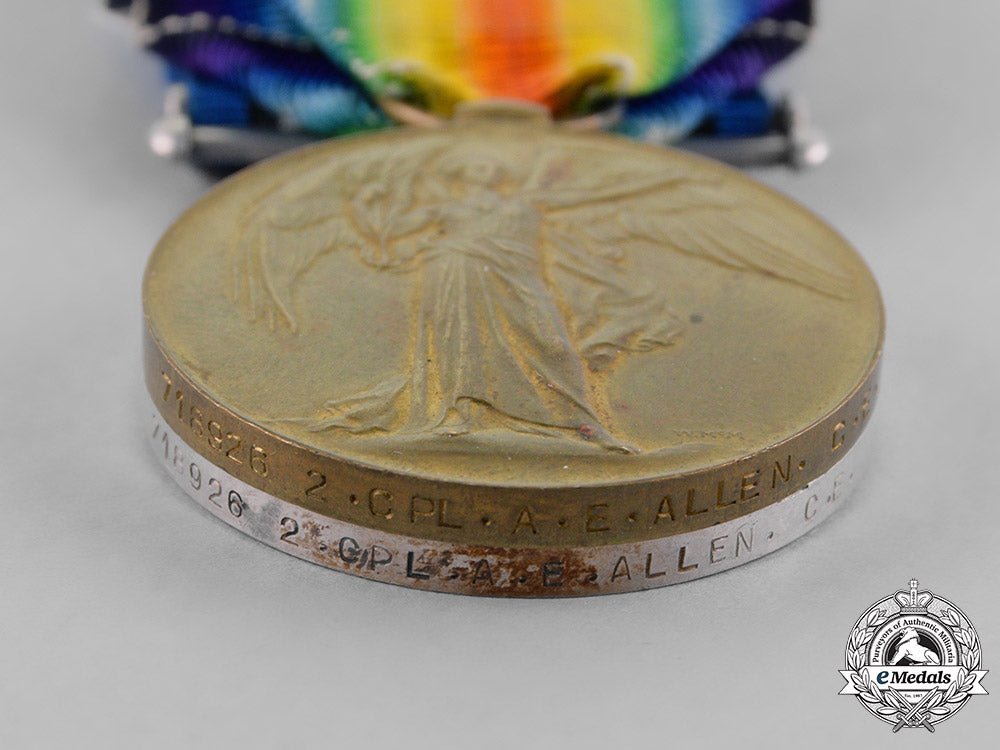
You May Also Like
Germany, Third Reich. A Mixed Lot of Tyrolean Marksmanship Badges
G52930
Germany, SS. An Estonian Waffen-SS Volunteer’s Sleeve Shield
G50381
Germany, SS. A Waffen-SS Sturmmann Sleeve Insignia
G52846
Germany, Third Reich; Slovakia, First Republic. A Mixed Lot of Wartime Postcards
G52905
Germany, Third Reich. A Pair of Tyrolean Marksmanship Badges
G52981
-
Germany, Third Reich. A Mixed Lot of Tyrolean Marksmanship Badges
G52930
Add to CartRegular price $135 USDRegular price $0 USD Sale price $135 USDUnit price / per -
Germany, SS. An Estonian Waffen-SS Volunteer’s Sleeve Shield
G50381
Add to CartRegular price $150 USDRegular price $0 USD Sale price $150 USDUnit price / per -
Germany, SS. A Waffen-SS Sturmmann Sleeve Insignia
G52846
Add to CartRegular price $135 USDRegular price $0 USD Sale price $135 USDUnit price / per -
Germany, Third Reich; Slovakia, First Republic. A Mixed Lot of Wartime Postcards
G52905
Add to CartRegular price $135 USDRegular price $0 USD Sale price $135 USDUnit price / per -
Germany, Third Reich. A Pair of Tyrolean Marksmanship Badges
G52981
Add to CartRegular price $135 USDRegular price $0 USD Sale price $135 USDUnit price / per
Do you have a similar item you are interested in selling?
Please complete the form and our client care representatives will contact you.
Sell Item
















